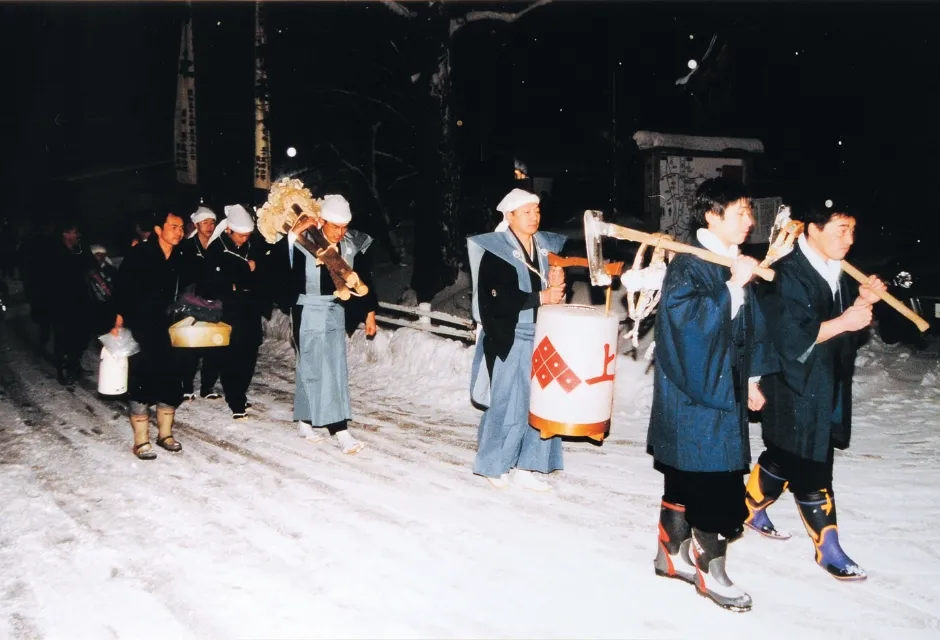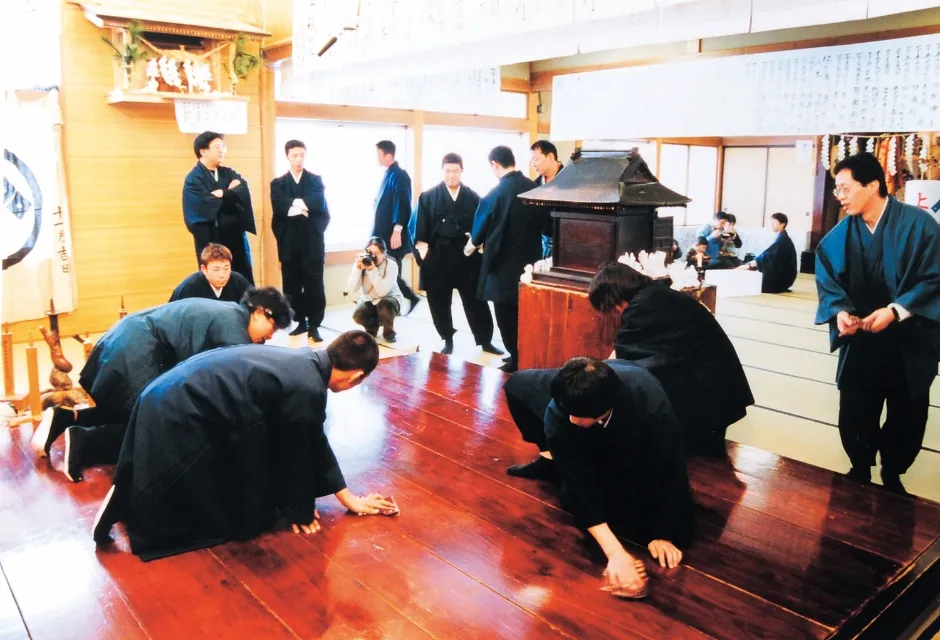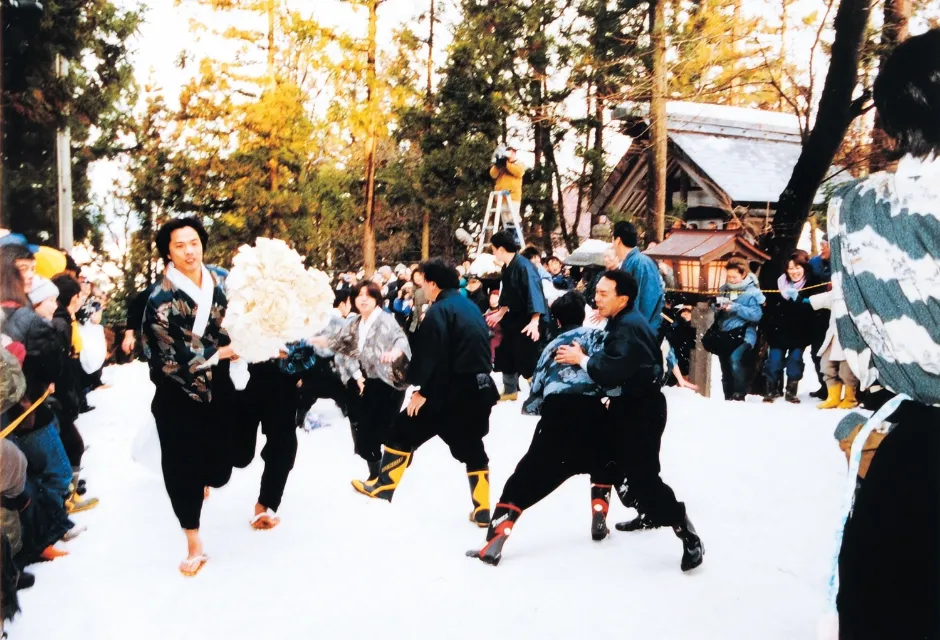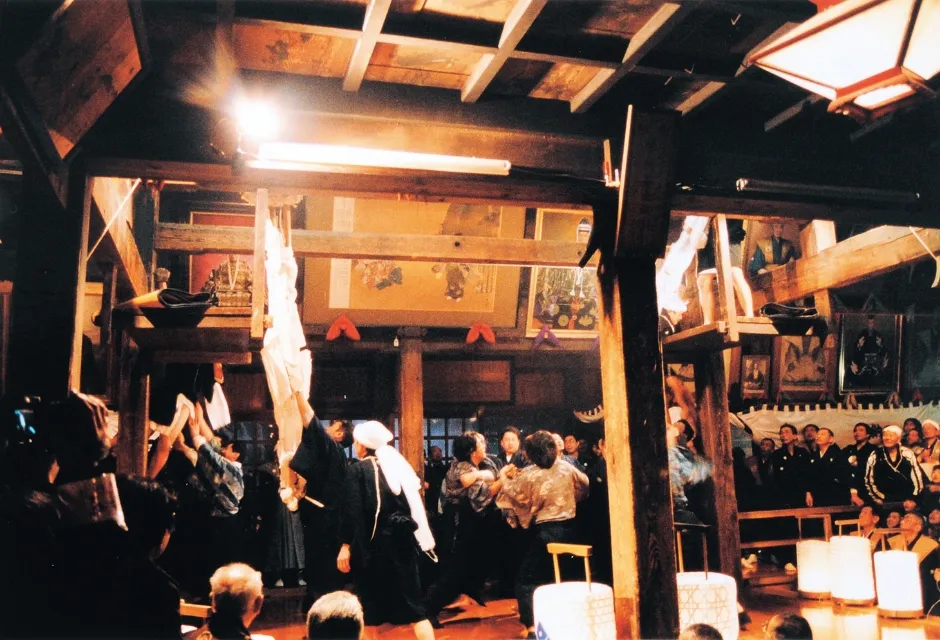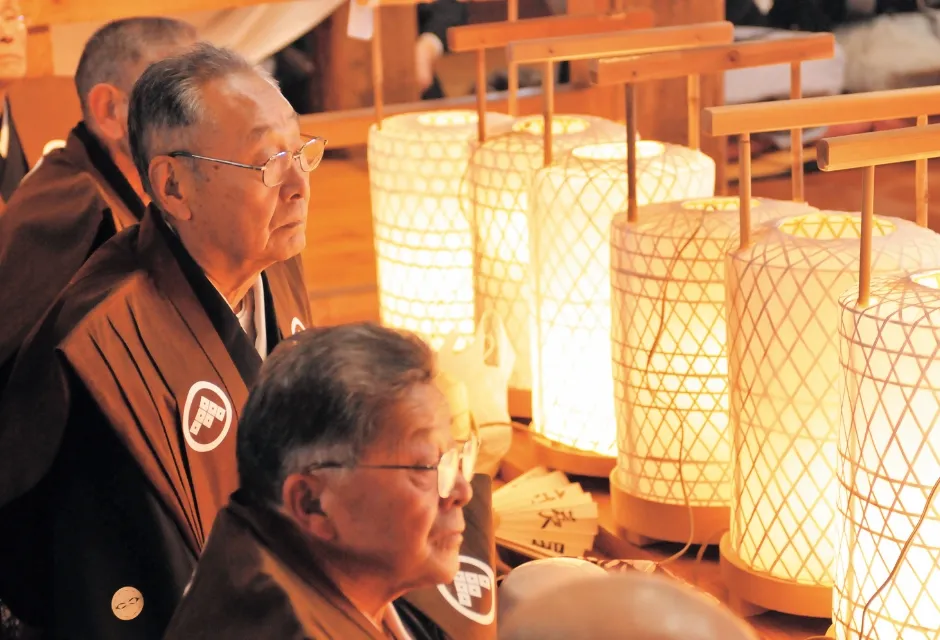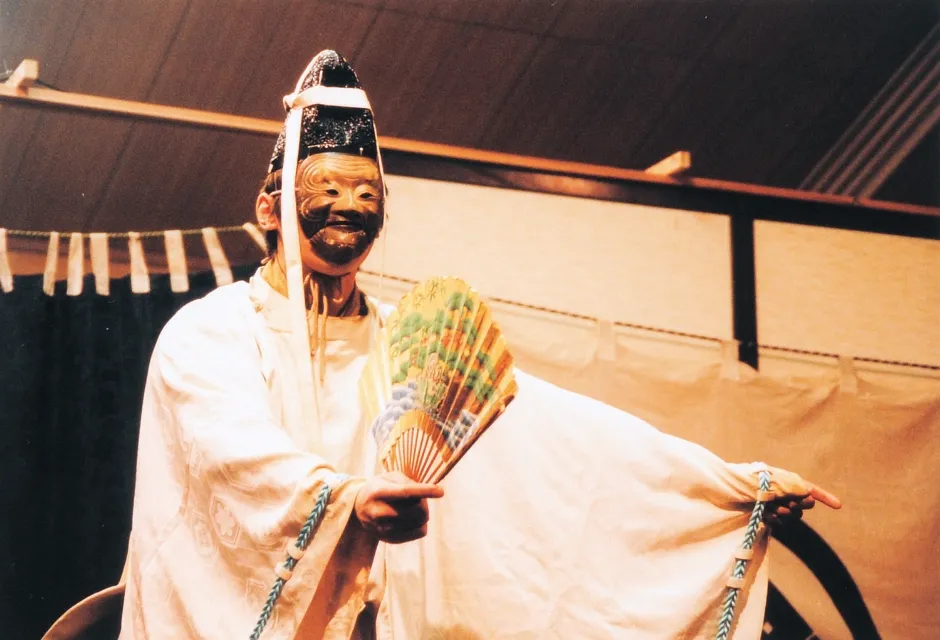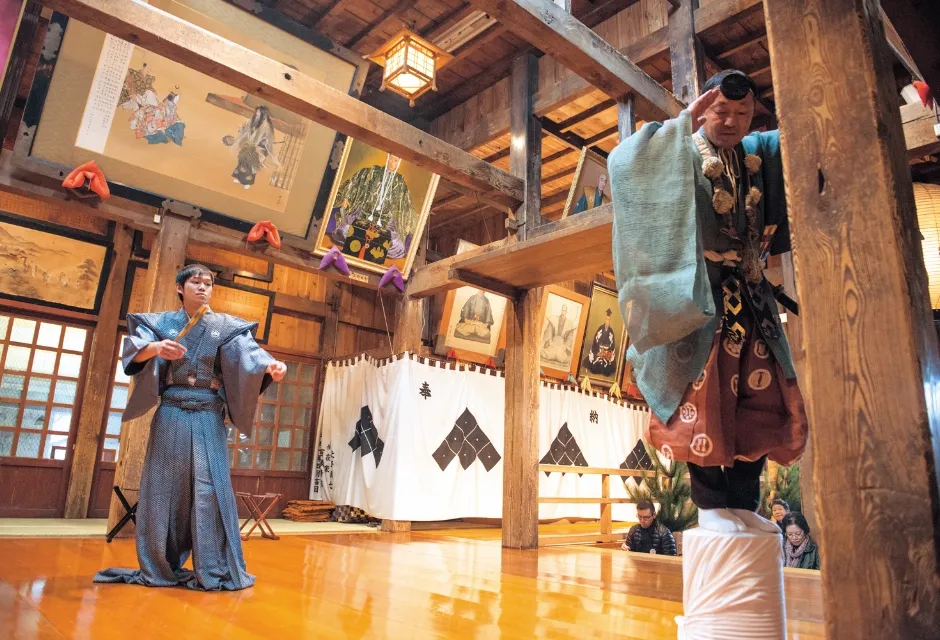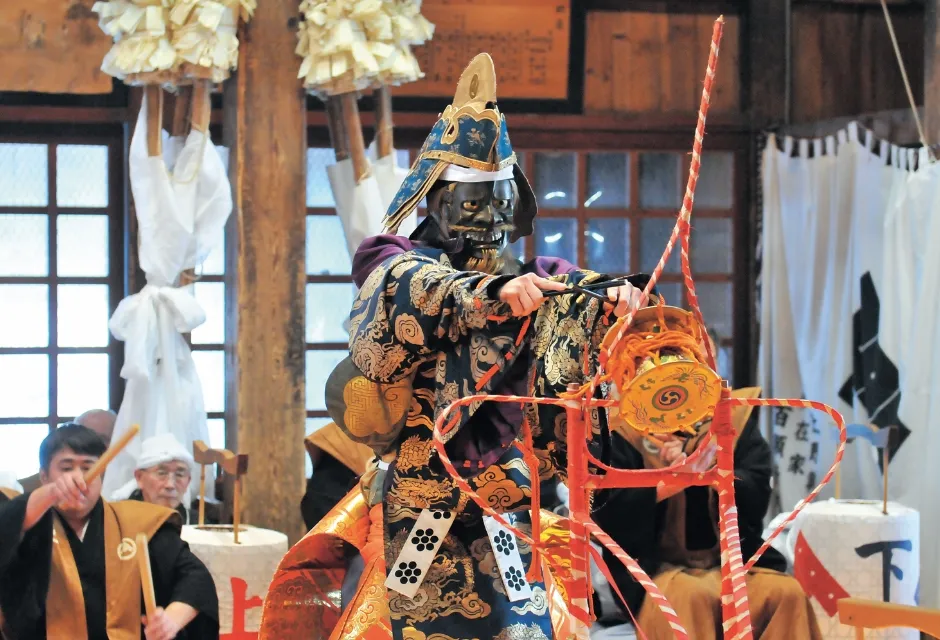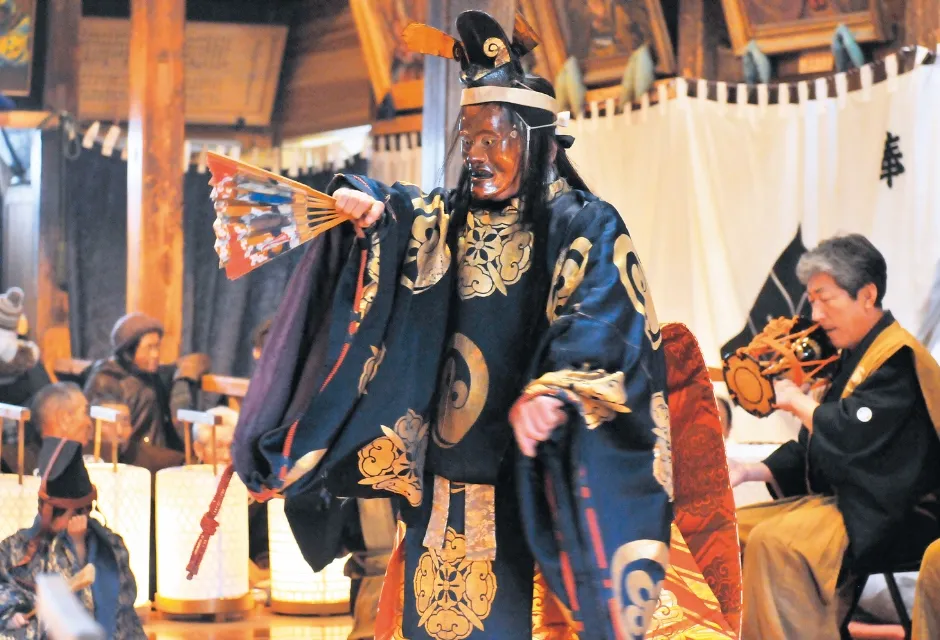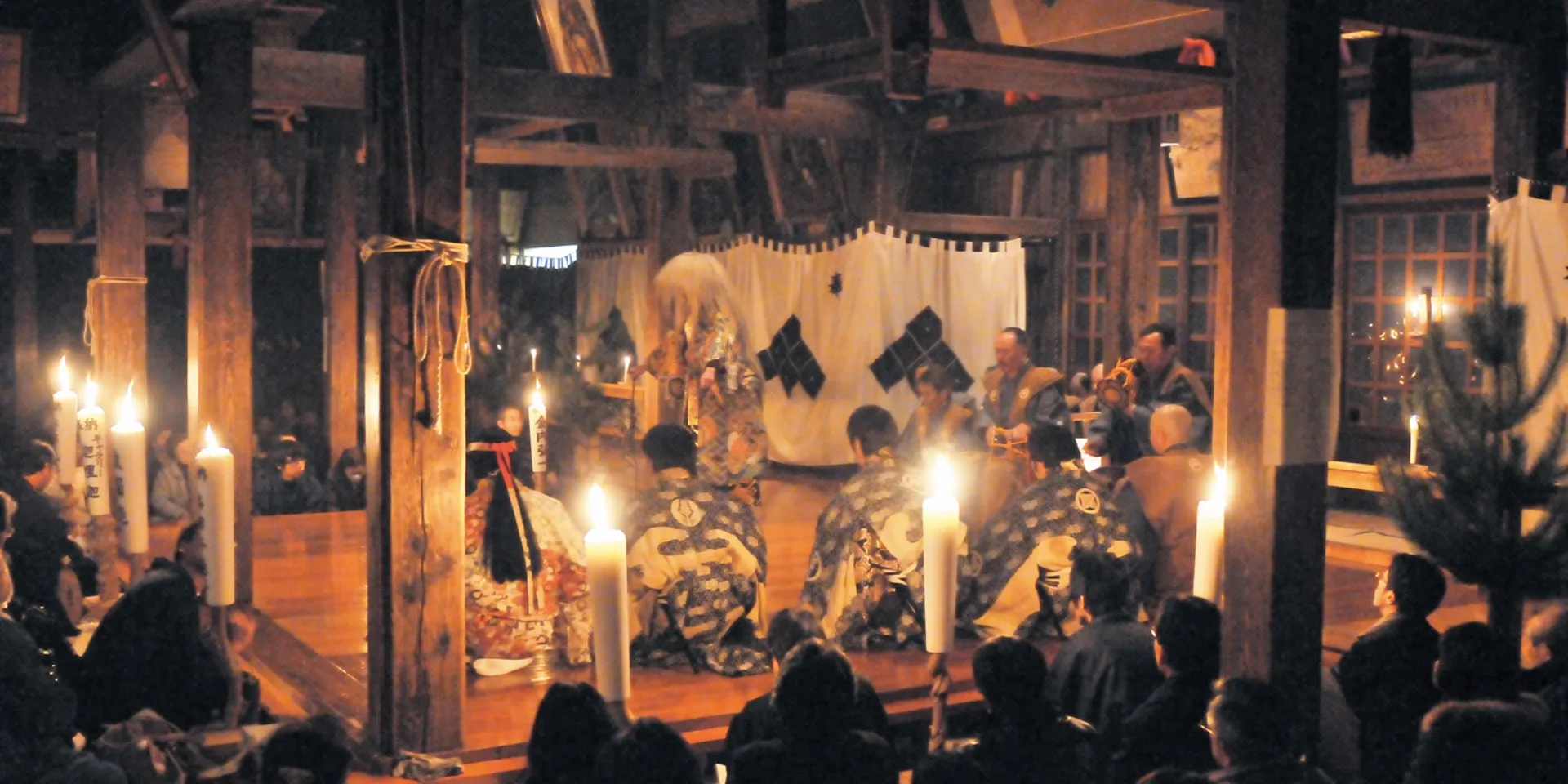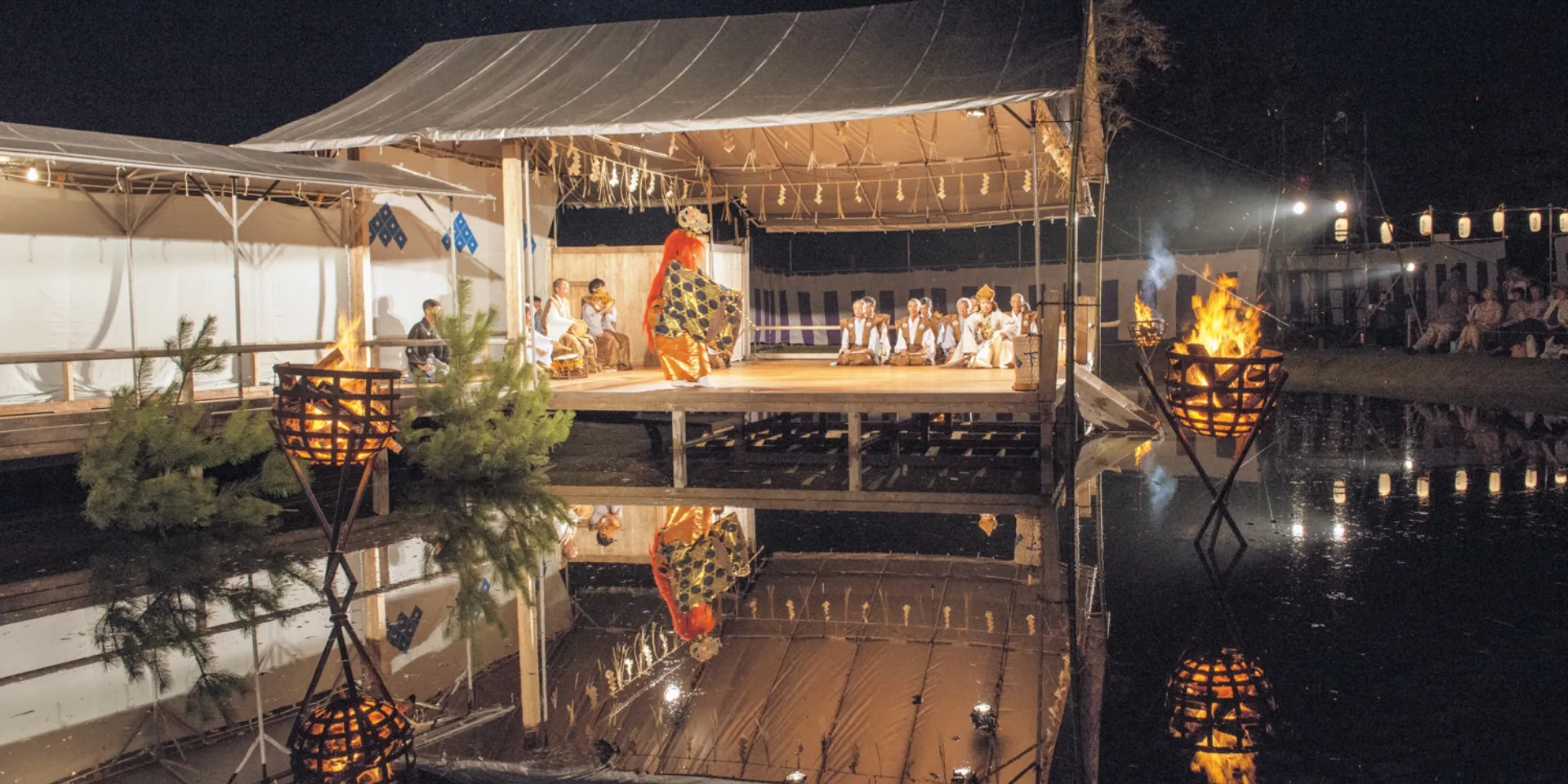Special Feature
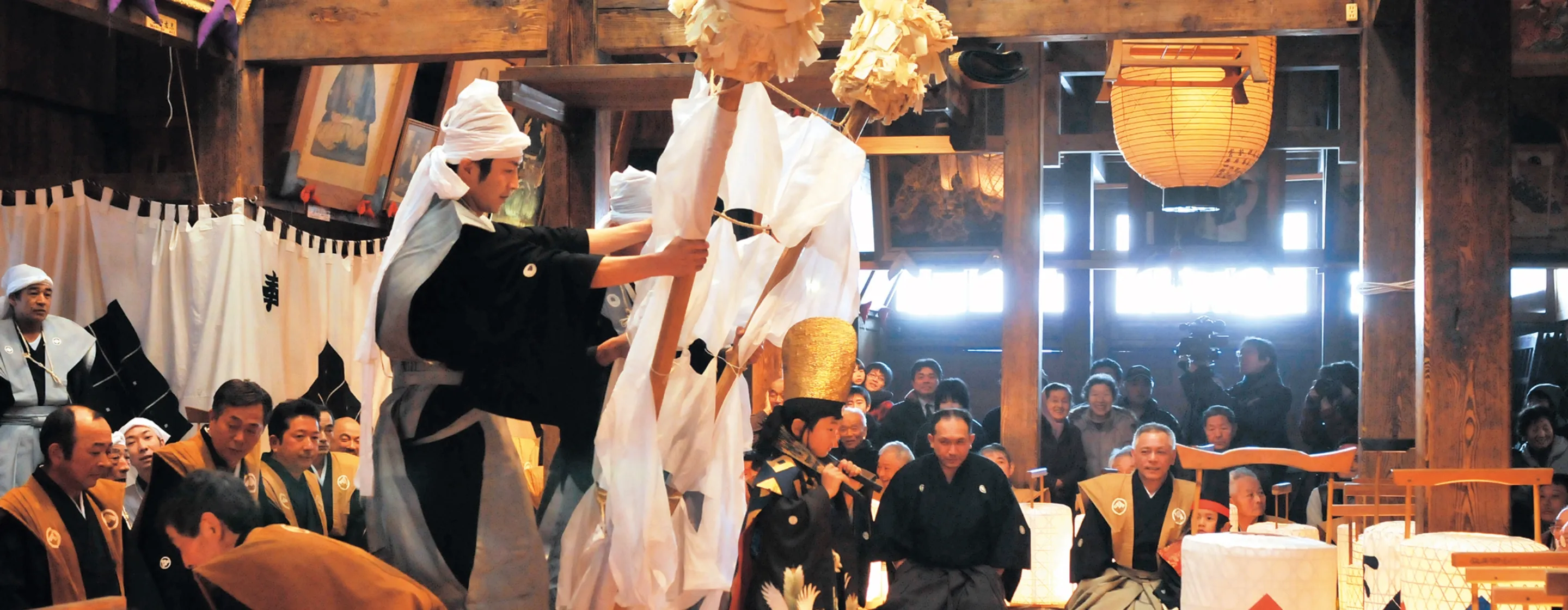
The Home of Kurokawa Noh
Kurokawa Noh is a distinct style of Noh theater performed in the district of Kurokawa, Tsuruoka City. Its history goes back some 500 years, and the Japanese government designated Kurokawa Noh as an Important Intangible Folk Cultural Property in 1976. Kurokawa Noh involves Shinto ritual performances held throughout the year that are dedicated to Kasuga no kami, one of the Shinto deities. Of them, the Ogisai Festival, held on February 1 and 2, is an annual highlight that offers a chance to see local religious traditions and experience all that Kurokawa Noh has to offer. Noh performances during the festival traditionally took place in the homes of the two chosen families for that year, who are also parishioners of the shrine. As part of the festival, they welcomed the guardian deity of the shrine into their homes. Called the Toya system, this taking of turns hosting the guardian deity and the Noh performances has long been a cherished tradition in Kurokawa and continues today in the district’s local community centers. We visited the Kurokawa district in early winter, when excitement for the festival was starting to build.
Festival Preparations All Winter Long
Kurokawa lies at the foot of Mt. Gassan on the southern side of Shonai Plains. There are two Noh groups in Kurokawa, the Kami-za and the Shimo-za, which each perform during the Ogisai Festival. On December 9, work parties to make traditional ropes used in Shinto rituals were held at the homes of the two chosen Toya families for the year. Kyujiro Ueno and Zenbei Heishin, are the heads of the two chosen Toya families for Kami-za, and Shimo-za respectively. Including relatives of these Toya families and residents of Kurokawa, about 30 people each spent the day with the Kami-za and Shimo-za Toya family heads to make ropes from dried rice straw. On December 15, the Shimotsuki Jugoyasai Festival (fifteenth of Shimotsuki festival) took place at Rokusho-jinja Shrine, where prayers for preparations to go smoothly for both Toya families were offered. This kicks off the Ogisai Festival season in the home of Kurokawa Noh.
The Ogisai Festival on February 1 and 2 is the biggest annual event in Kurokawa. During this time, Ogi-sama are brought to the homes of the two Toya families and the Lunar New Year celebrations are seen in together with the local parishioners. Ogi-sama are structures into which the guardian deity of Kasuga-jinja Shrine is transferred so that it can be welcomed into the homes of the Toya families for the Noh performances. The structures are made from three long wood poles held together with rope and wrapped in white cloth. Twelve hamlets lie along the old road that leads from Kasuga-jinja Shrine. The hamlets to the south form the Kami-za group, while those to the north form the Shimo-za group. Every year, one family from each group is selected to be Toya family that will host Ogi-sama during the Ogisai Festival for that year. Upon selection everyone in those Toya families help with the festival preparations.
Ueno, the head of the Toya family for Kami-za, describes receiving advice about the vast quantity of things that needed to prepared from another family in his hamlet of Takinoue who had served as the Toya family of 2007. The Ueno family began collecting firewood to use during the festival two years ago and has been gathering large amounts of wild vegetables (sansai), plums, walnuts, soybeans, persimmons, and other seasonal crops since the previous spring. These will be served to guests during the festival. After the rope-making work parties in December, many more projects requiring lots of helping hands await in January. Knowing this, the family requested help from relatives and people in other hamlets before the year’s end.
Ueno and Heishin, the heads of the two Toya families this year, have been waiting to be chosen for more than ten years. Heishin, of the Toya family for Shimo-za, talks with admiration about his father, who spent his entire life in Kurokawa. “My father was a long-time performer of Kurokawa Noh, so there is no greater joy for me than being selected.”
At a meeting of the Noh groups, called Kogyo, held on January 3, the members of Kami-za and Shimo-za gather separately to hear the announcement of who will be performing which Noh roles during the Ogisai Festival as well as the new members of Meguri no Otona-shu. Meguri no Otona-shu is a group made up of older persons whose families are officially designated as future Toya families. The oldest people in the group will, for the year that they are selected, serve as the head of their family, thus becoming a Toya family head. It has long been a tradition in Kurokawa to bestow honors on the oldest people in the hamlet rather than those with high social or family status.
Noh rehearsals start the day after the Kogyo meeting and continue every night until the Ogisai Festival.
The Jushichiyasai Festival (seventeenth night festival) is held on January 17. At the festival, the chief priest of Kasuga-jinja Shrine bestows the titles of Dewa-no-kami and Owari-no-kami on the heads of the two Toya families. Until the end of the Ogisai Festival, they will be referred to by these titles instead of their names.
Several days later, tofu is grilled in outdoor cooking sheds newly constructed by the Toya families for this purpose. Hamlet members gather at the cooking sheds and spend two days grilling thousands of skewers of tofu. After being grilled, the tofu is exposed to the winter air and frozen.
On January 29, three days before the Ogisai Festival, a rope is suspended in the garden below Kasuga-jinja Shrine to mark the separation between sacred and profane spaces, and the guardian deity of Kasuga is invoked. On January 30, the heads of the two Toya families and the Noh performers gather at Kasuga-jinja Shrine to pray for the safe holding of the Ogisai Festival. On January 31, messengers from the two Toya families go around to parishioners’ homes to formerly announce the holding of the festival.
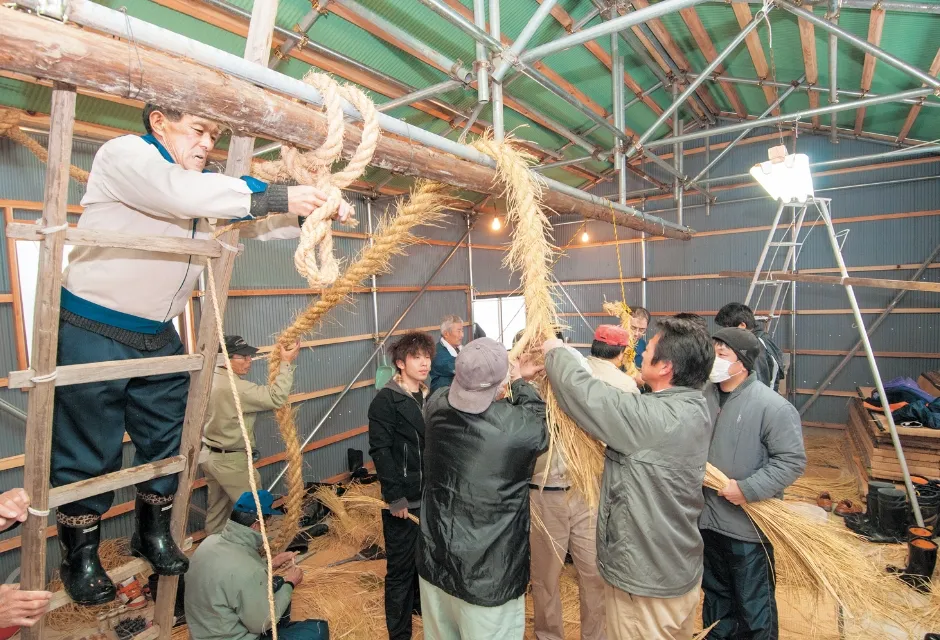
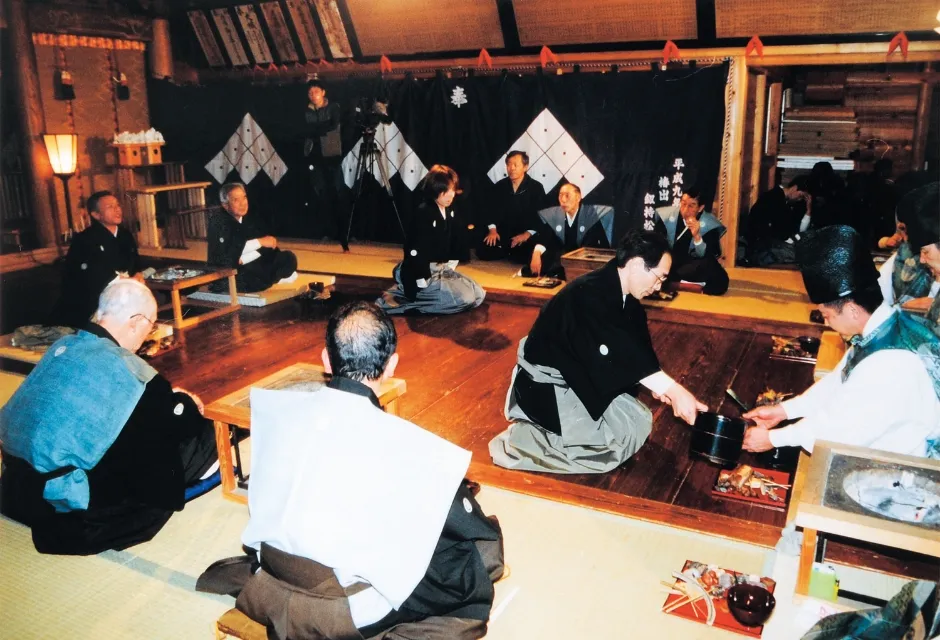
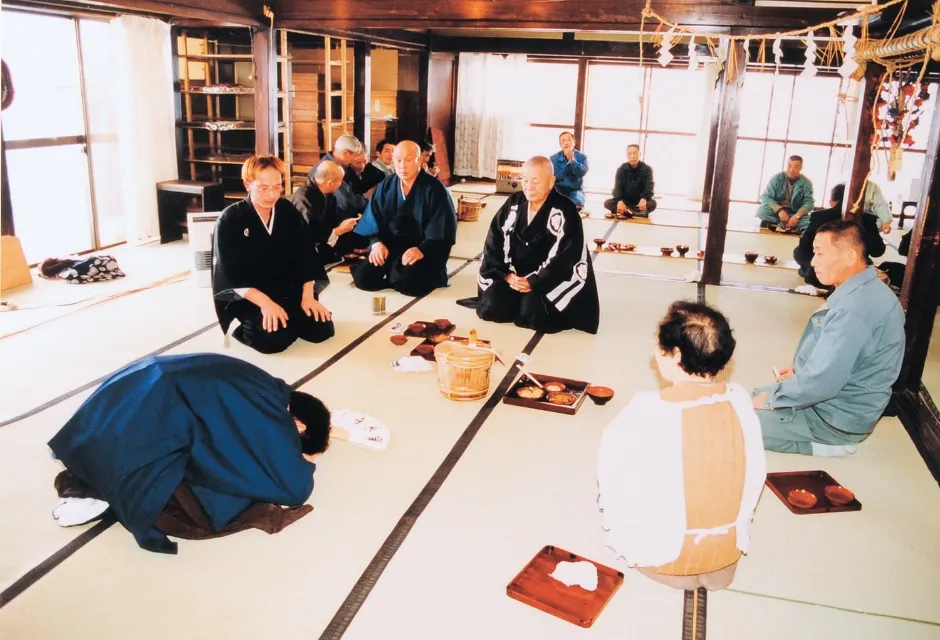
Festival and Ritual Noh to Give Thanks to the Guardian Deity
On February 1, it’s finally time for the Ogisai Festival to begin. At the Toya families’ homes, the people who will receive the guardian deity purify their bodies in the midnight hours. They assemble at Kasuga-jinja Shrine at three in the morning. Shinto priests then transfer the guardian deity of Kasuga to the two Ogi-sama for the Toya families of Kami-za and Shimo-za and hand them over them to the people who have come to receive them. At dawn, a procession of people carrying the Ogi-sama depart the shrine and head to the Kami-za and Shimo-za Toya families’ homes. The heads of the two families, dressed in the traditional formal robes that samurai wore during the Edo Period (1603–1868), then receive the Ogi-sama.
Afterward, priests attach white cloth to the Ogi-sama at the Toya families’ homes and various events are conducted by the Noh groups following their own traditional customs. This includes a meeting of each Noh group’s family representatives and the entertaining of hamlet women and children and guests by the Kami-za and Shimo-za groups.
Once the entertainment has finished, around three in the afternoon, preparations begin on the Noh stages and the performers enter their dressing rooms. The stage performances begin around six in the evening, lit by flickering candlelight.
We asked Jushi Endo, a senior priest at Kasuga-jinja Shrine who conducts Shinto rituals, about the features of ritual Kurokawa Noh. “Since Kurokawa Noh is performed for the enjoyment of the guardian deity, it’s not performed for the audience but for the kami. Even when Noh is performed at the National Noh Theatre in Tokyo or in a foreign country, before the performance there is always a ritual ceremony to welcome the Kasuga no kami to the stage. I also think Kurokawa is the only place in Japan where a program of all five plays is performed, due to the amount of time it takes. In the Ogisai Festival, Kurokawa Noh is continuously performed throughout the night until morning before the physical object in which the deity inheres.” Endo continued, “The most distinctive feature of Kurokawa Noh is how it has been passed down in the separate Kami-za and Shimo-za groups. If the groups did not have their rivalry, where they also help and learn from each other while striving to outperform the other, I do not think Kurokawa Noh would have survived the way it has.”
The night sky grows lighter around the time the entire program finishes. On the morning of February 2, the performers and heads of the two Toya families depart for Kasuga-jinja Shrine carrying the Ogi-sama with them. The people left behind help clean up, and the Toya families of next year’s Ogisai Festival soon come to receive the ritual articles that have been arranged in the tokonoma alcove.
The Kami-za and Shimo-za processions leaving the Toya families’ homes race to see which group can lean the Ogi-sama on a pillar in Kasuga-jinja Shrine’s hall first. Afterward, both groups once again perform Noh, this time, in the shrine’s hall.
The second day of Noh performances ends around three-thirty in the afternoon. The groups then race against each other in various Shinto rituals, such as lifting the Ogi-sama onto a beam, filling the shrine hall with the energy of youth. Afterward, the Ogi-sama are returned back to their place in the shrine hall and the festival comes to a close. Banquets are held that evening in the homes of the Toya families to celebrate the safe conclusion of their duties. For the next three days, banquets are also held at the homes of next year’s Toya families, marking the start of preparations for the next Ogisai Festival.
Over the long history of this small Kurokawa district, the worship of guardian deities, traditional performing arts, and the spirit of mutual aid have been preserved. Thought to have been lost to time, their preservation here in Kurokawa is nothing short of a miracle. Many people will again come to the Ogisai Festival in the depths of winter this year to see this miracle for themselves.
